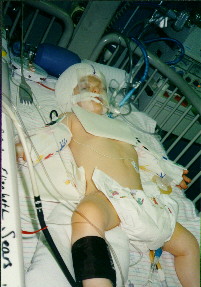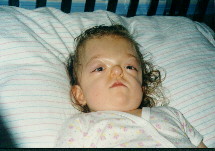|
We met with Dr. Kalus and got found out more about Apert. We had met
a geneticist in NICU who had counseled us and gave us several of the articles
from Clinics in Plastic Surgery (April 1991). He told us of a group of
physicians he was involved with - the South Carolina Center for Craniofacial
Anomalies. The group met periodically and Lizzie would be seen by every
specialist, then the group would meet and form a plan for her. It was too
good to be true! The group is wonderful, and we see them at least every
year.
The goal was to get Lizzie to ten pounds prior to the surgery to release
her fused cranium. We tried, and she tried, but she had developed a terrible
stomach problem, frequently not able to keep even the mildest formula down.
We tried every formula available, but when time for surgery came she was
still only about 9 1/2 pounds. Dr. Kalus said she would do just fine. She
was hospitalized the night before surgery, and we were more than a little
nervous. Something did not feel right. The feeling persisted right up through
the time in surgical waiting when the anesthesiologist came in to talk
to us. Then Dr. Kalus came in, and said there would be no surgery that
day - a special tool he had ordered for the surgery had not arrived. While
we were frustrated, we were also both extremely relieved.
We took the opportunity to try and get her stomach problems straightened
out once and for all. Her gastroenterologist was able to run some tests
on her and determined that the problem could be treated by some extremely
heavy duty antibiotics. They did their job, and finally she was able to
keep formula down, and gained a little weight.
I lost count of the visits to various doctors during the first six months.
The surgery was rescheduled, and Lizzie was doing much better, and this
time everything felt right. Although the surgery lasted all day long, the
operating room kept us informed of her progress. She did pretty well in
recovery. The poor thing was swollen and pasty looking, her head in a turban.
Dr. Kalus was very pleased, saying everything had gone even better than
expected. Dr. Kalus had done the work jointly with Dr. Lenwood Smith, Lizzie's
regular neurosurgeon.
 They had told
us she would probably be black and blue, stay swollen, and run a fever,
and be in the hospital for 10 days to two weeks. But after only six days,
she was ready to go home - no bruises, no fever. She is one tough kid.
When the bandages came off, her bone structure was so different than what
we were used to - and they told us it would take some time for us to get
used to it, and also for the swelling to go down. Both were true. After
a couple of weeks, everything settled down and she had the smoothest forehead,
and very graceful temples. She was more beautiful than ever. They had told
us she would probably be black and blue, stay swollen, and run a fever,
and be in the hospital for 10 days to two weeks. But after only six days,
she was ready to go home - no bruises, no fever. She is one tough kid.
When the bandages came off, her bone structure was so different than what
we were used to - and they told us it would take some time for us to get
used to it, and also for the swelling to go down. Both were true. After
a couple of weeks, everything settled down and she had the smoothest forehead,
and very graceful temples. She was more beautiful than ever.
Summer quickly turned to fall, and we noticed a remarkable increase
in her personality after surgery. Maybe it was releasing the brain and
giving it room to grow, or maybe it was the curing of her stomach problems,
but she was so happy now and into everything. She would move herself around
by lying on her back, and propelled herself like an inch worm using the
back of her head.
By Thanksgiving, we began to worry about a bulging which was growing
in the center of her forehead. It was so gradual we really did not notice
it. Grandparents and others began to point it out to us. The soft spots
in the top of her head left during surgery had filled in with bone, which
we assumed was normal. Just to be on the safe side, we scheduled an appointment
with the neurosurgeon. His news was not good.
The "bone" which had filled in was not bone, but felt as hard
as bone. Her poor head was pressurized to the point where the brain was
being pressed into all the soft spots, and had literally dissolved the
new forehead from the inside, and was now pushing through making the bulge.
The shunt had failed, probably due to the growth activity after the cranial
surgery. There was no option - surgery was scheduled right away, and the
shunt was replaced.
Now, of course, the cranial surgery would have to be redone to repair
the damage done by the pressure to the forehead. That surgery was scheduled
for February. The forehead was replaced, and the shunt once again failed
- but this time everyone was waiting for it to happen, so it was caught
before too much damage was done. Elizabeth still has a bulge in her forehead,
but the cycle has stopped for now and no further cranial surgery is planned
at this time.
So now, she has had three shunts and two cranial surgeries. It was time
to start on her hands in 1993. We consulted with not only Dr. Kalus but
also the Shriner's Hospital in Greenville. If you don't know the Shriners,
make it a point to get to know them. They handle any case where the child
is 18 or younger and has walking or any kind of mobility disability, or
is burned. Every dollar of funds raised by the Shriners goes into an endowment
fund, and they operate 22 orthopedic hospitals and three burn centers around
the US from the interest on the endowment fund. No child or parent is ever
asked to pay a dime for services. All of the props the Shriners use in
their fund raising are paid for directly by the individual Shriners - funds
raised are not touched for any reason.
We also consulted with a local physician who later became famous with
a groundbreaking procedure for lengthening bone called illizerov (sp?)
in which he wanted to separate Elizabeth's fingers by threading metal rods
through her bones, and applying gradual pressure to encourage the separation
of the fingers prior to traditional surgery. Dr. Kalus tactfully advised
against this procedure, and we agreed. We did not want Elizabeth to be
the guinea pig. The procedure would have been painful, and there would
have been a significant risk of infection.
Teeter had her first hand surgery in July of 1993, releasing the index
and pinkie fingers of her right hand. She had skin for grafts taken from
the area where the leg meets the torso. The only problem we had was after
surgery - by now she was so active she pulled apart the incision where
they had taken the skin, and Dr. Kalus had to meet us at the emergency
room to put her back together. The second hand surgery, the same procedure
on the left hand, came that October, along with the repair of a double
congenital hernia.
Back Top
Next |
